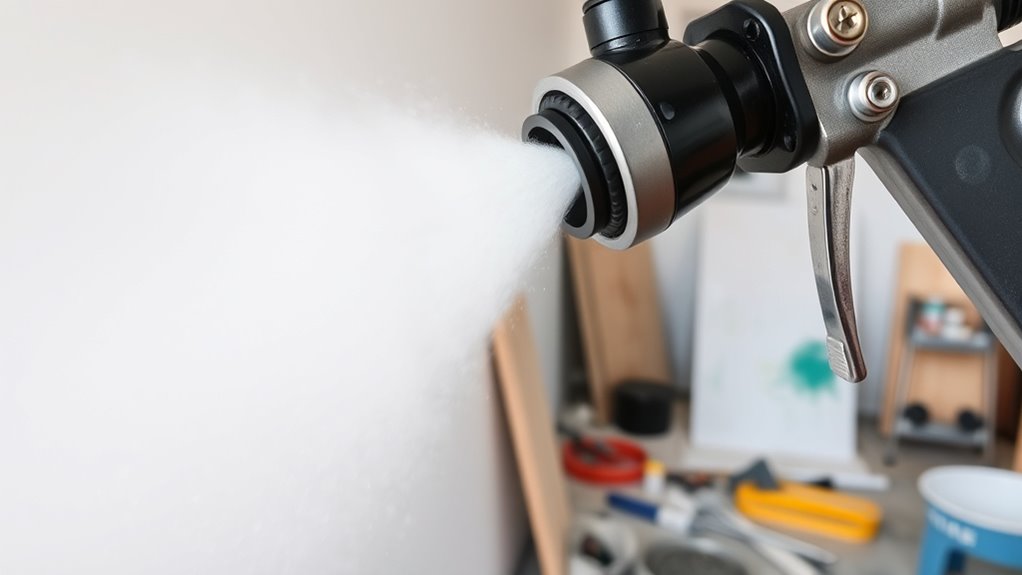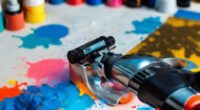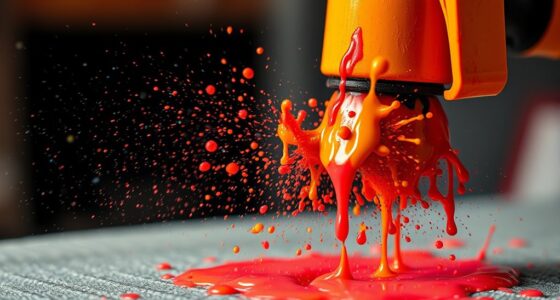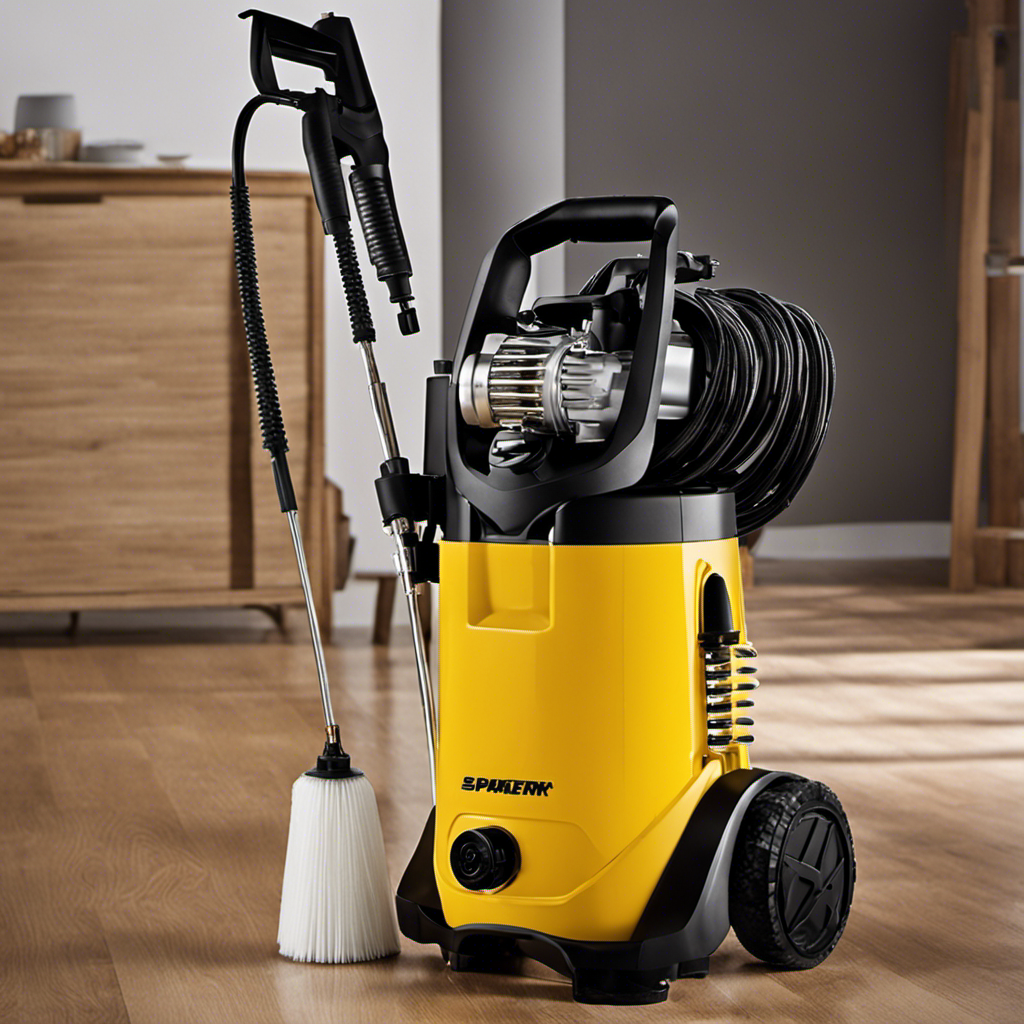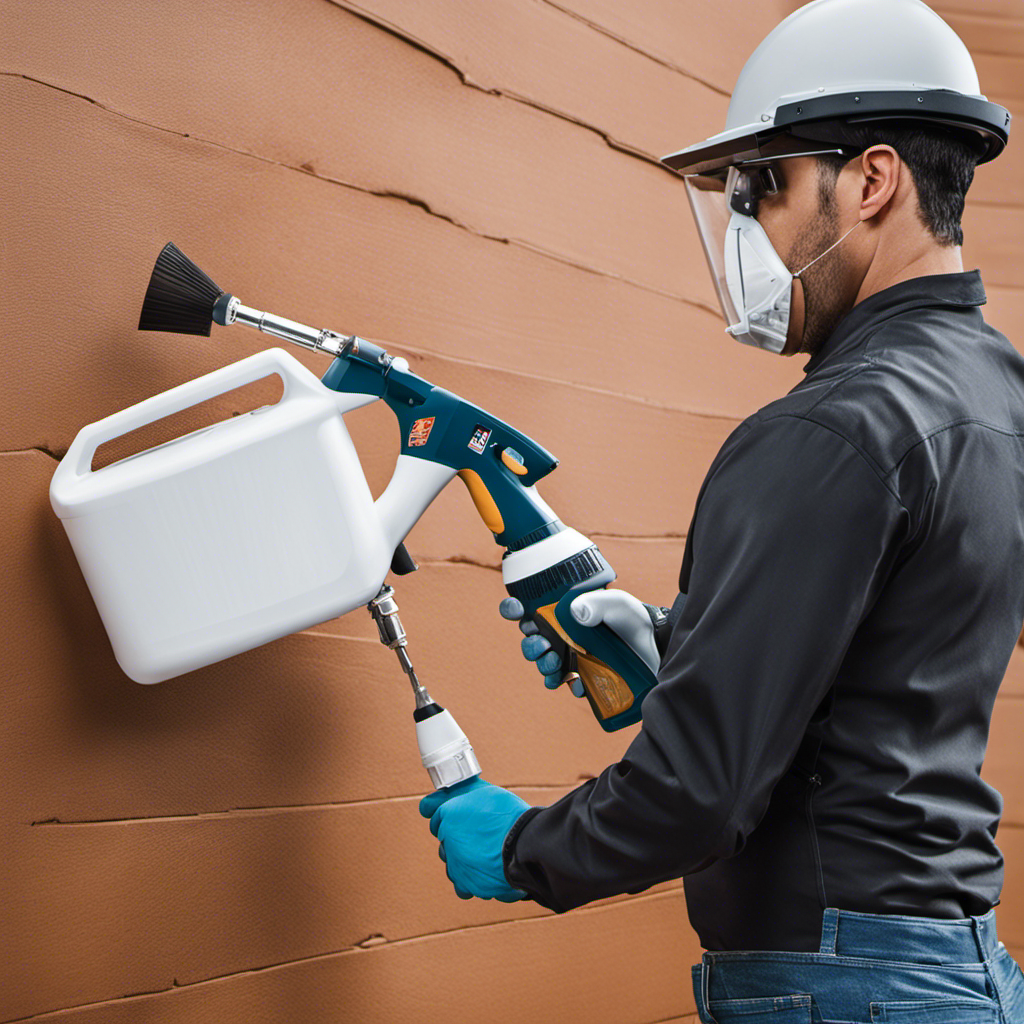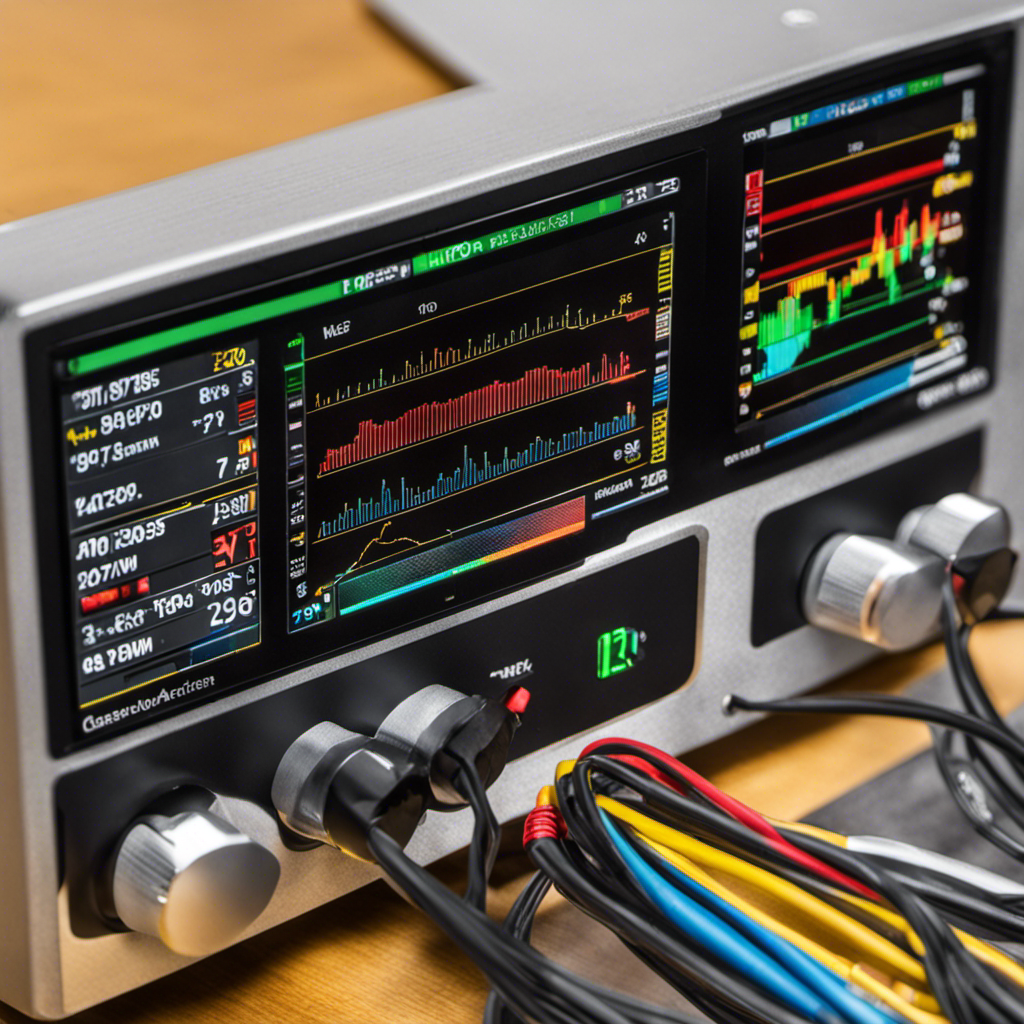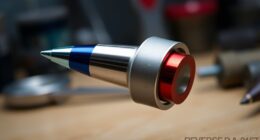To fix uneven spray patterns, start by inspecting and cleaning your nozzles to remove clogs or debris. Check for wear or damage and replace parts as needed. Adjust the pressure settings to the manufacturer’s recommendations, ensuring consistent flow. Examine the spray tip for cracks or blockages and tighten loose fittings to prevent leaks. For more detailed steps, continue exploring how proper maintenance and calibration can improve your spraying results.
Key Takeaways
- Regularly clean and inspect spray nozzles to prevent clogs and damage that cause uneven spray patterns.
- Check and adjust pressure settings accurately, calibrating equipment for consistent spray flow.
- Examine and replace worn or damaged nozzles, seals, and fittings to ensure proper spray distribution.
- Maintain equipment by tightening fittings and removing obstructions to avoid leaks and flow disruptions.
- Perform routine maintenance and use trusted products to keep spray patterns consistent and prevent issues.
Checking and Cleaning the Nozzle
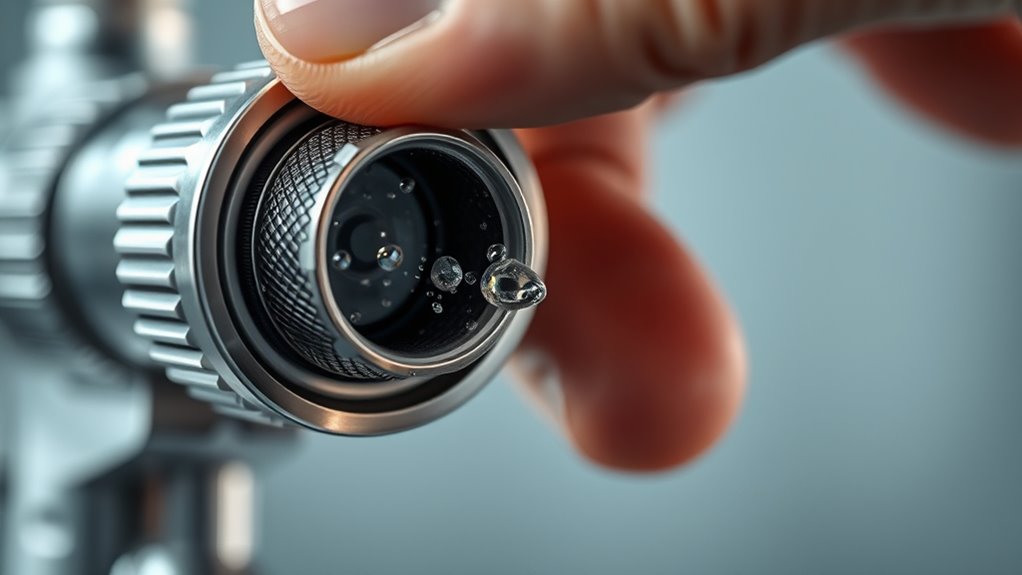
To guarantee your spray pattern is even and consistent, start by inspecting the nozzle for any clogs or debris. The nozzle material can affect how easily it collects buildup, so choose durable options like metal or high-quality plastic. Examine the nozzle’s spray angle, as a damaged or worn nozzle can alter the spray pattern, leading to uneven coverage. Clean the nozzle carefully using a soft brush or compressed air to remove any particles that may obstruct the flow. Avoid using sharp objects that could damage the nozzle, especially if it’s made from softer materials. Ensuring the nozzle is free of obstructions and in good condition helps maintain the correct spray angle and pattern, resulting in a smooth, even spray every time. Additionally, checking the nozzle’s material can help prevent premature wear and tear, ensuring lasting performance. Proper nozzle maintenance also extends the lifespan of your equipment and keeps your spraying consistent.
Inspecting for Clogs or Blockages
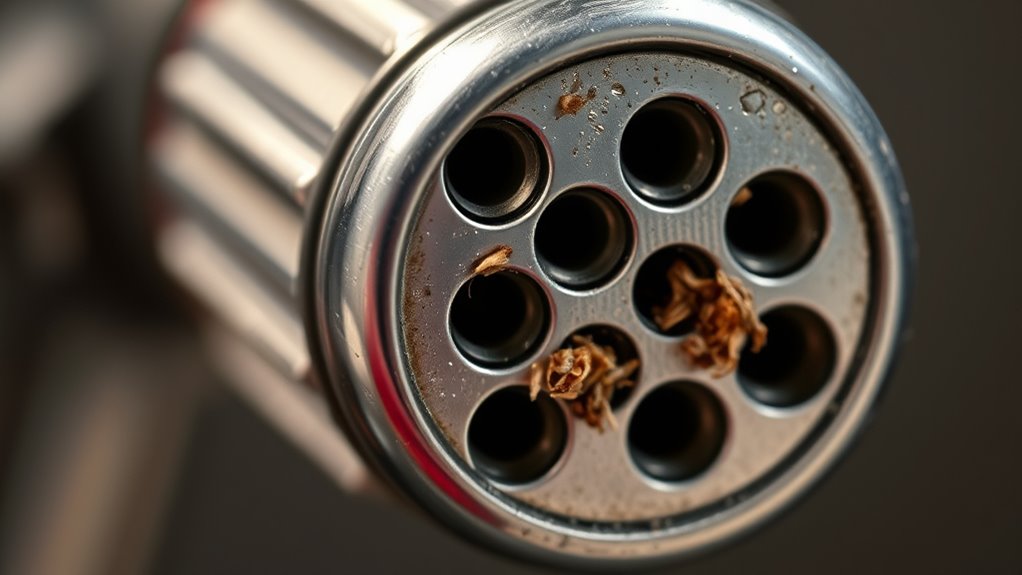
Start by carefully examining the nozzle for any visible clogs or debris. If you notice obstructions, remove them using a small tool or rinse the nozzle thoroughly. Clearing these blockages guarantees your spray pattern flows evenly and functions correctly. Regular maintenance can prevent clogged nozzles, ensuring consistent performance. Additionally, understanding the importance of proper equipment care can extend the lifespan of your tools and improve their efficiency. Being aware of essential oil properties can also help prevent buildup and residue that might contribute to nozzle blockages. Incorporating appropriate cleaning methods into your routine can further reduce the risk of residue buildup in spray mechanisms.
Check Nozzle Carefully
A clogged or blocked nozzle can be critically affected by spray patterns, so it’s vital to examine it carefully. First, inspect the nozzle for any visible debris or buildup that might impede flow. Second, check the nozzle size; an incorrect size can distort the spray angle, causing uneven coverage. Third, test the spray pattern by holding the nozzle up to a light to see if the opening is clear. Fourth, consider cleaning the nozzle with a soft brush or compressed air to remove clogs. Remember, a blocked nozzle can reduce spray efficiency and alter the spray angle, leading to uneven patterns. Ensuring the nozzle is free of obstructions and properly sized is key to achieving consistent, even spray distribution. Additionally, using professional-grade sprayers can help maintain optimal spray patterns and prevent blockages. Regular maintenance and understanding the impact of nozzle design are essential for consistent performance, especially since the Paint Sprayer Zone emphasizes the importance of proper nozzle selection for high-quality finishes. Proper nozzle inspection can significantly improve the overall spray quality and efficiency. Incorporating data-driven strategies into your maintenance routine can also help diagnose and prevent spray issues more effectively.
Clear Obstructions Properly
Inspecting the nozzle for clogs or blockages is a vital step in troubleshooting spray patterns. A clog can cause uneven paint flow, affecting both your spray angle and overall finish. First, check that your paint has the right consistency; too thick paint often leads to blockages. If the paint is too thick, thin it according to the manufacturer’s instructions. Next, remove the nozzle and inspect it closely for paint buildup or debris. Use a fine brush or a pin to clear any obstructions gently. Confirm the spray angle remains consistent by testing the spray pattern after clearing. Properly cleaning and maintaining the nozzle prevents future clogs, guaranteeing smooth, even spray patterns and a professional-looking finish. Additionally, regular maintenance of your spray equipment, including flushing with water or solvent, can help prevent clogs and blockages. Incorporating proper cleaning techniques also ensures longevity and optimal performance of your spray tools. Remember that the eye patch benefits include preventing the buildup of debris around delicate areas, similar to how maintaining spray equipment prevents clogs. Regular inspection and cleaning are essential to avoid equipment failure, ensuring consistent spray quality.
Adjusting the Pressure Settings
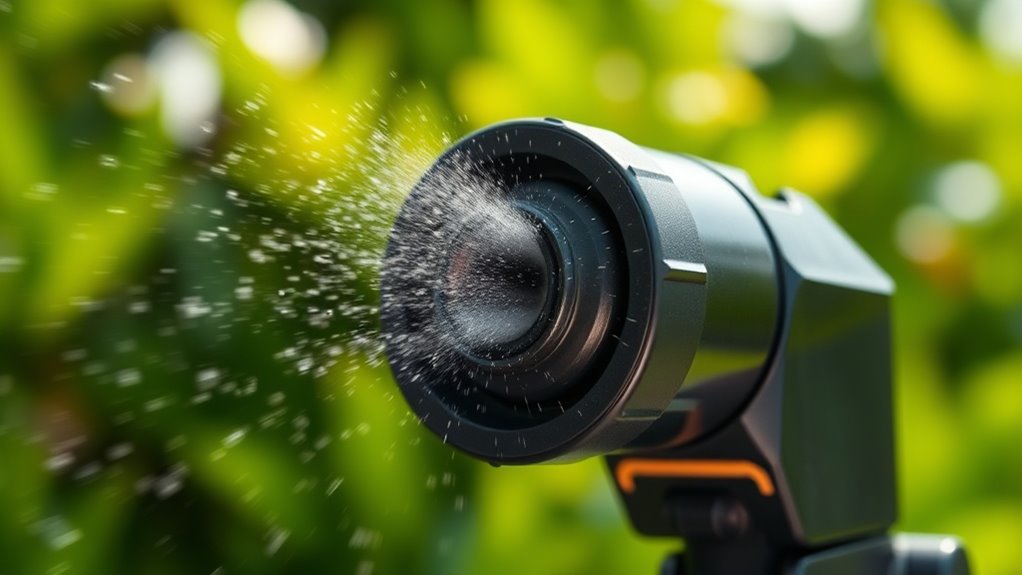
Adjusting the pressure settings on your sprayer is essential for achieving a consistent spray pattern and ideal coverage. Proper pressure regulation ensures you maintain spray consistency, preventing uneven coverage or drips. To optimize, consider these steps:
- Start with the recommended pressure listed on your product or equipment manual.
- Gradually increase or decrease pressure while observing the spray pattern.
- Use a pressure gauge to monitor adjustments precisely.
- Test spray on a scrap surface to confirm even coverage before starting your project.
- Regularly check for tuning opportunities to enhance your spraying performance and ensure the best results. Maintaining the correct pressure helps prevent issues like paint splattering or uneven application, which are common in airless paint sprayers. Additionally, understanding pressure settings can help you troubleshoot common spray pattern issues effectively. Proper pressure adjustment is also important for Gold IRA rollovers, as it ensures the stability and security of your assets during transfer and storage. Incorporating knowledge of sound vibrations and their effects may also assist in optimizing your equipment for smoother operation.
Examining the Spray Tip and Pattern
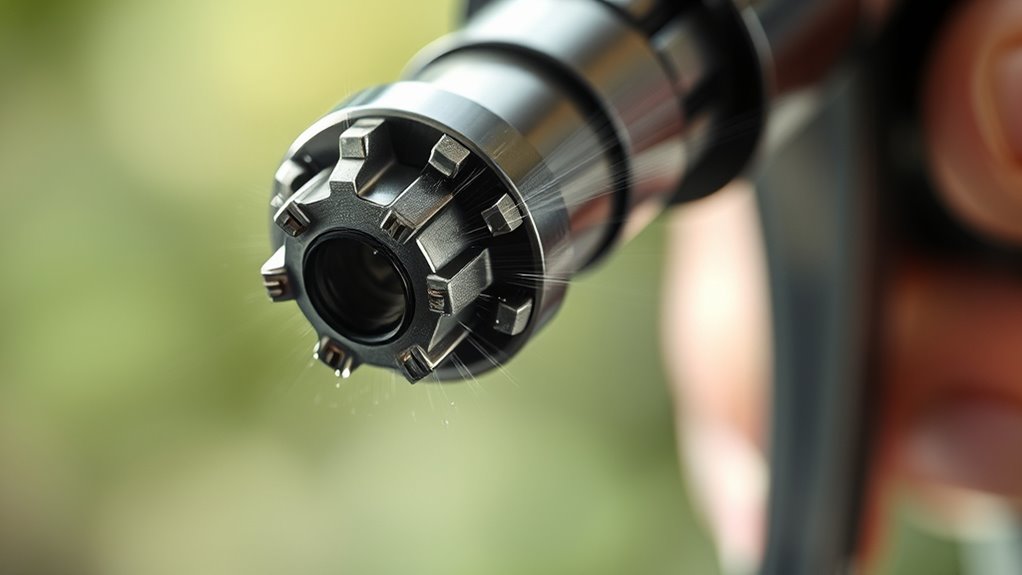
To guarantee your spray pattern is even and consistent, carefully examine the spray tip and the pattern it produces. First, check the spray angle; a narrow or irregular pattern often indicates a clogged or damaged tip. Look for uneven or broken edges in the spray pattern, which can signal nozzle misalignment. Ensure the nozzle is properly aligned with the spray gun or equipment, as misalignment causes inconsistent coverage. Clean the spray tip thoroughly to remove any paint buildup or debris that might distort the pattern. If the pattern remains uneven, inspect the spray tip for damage or wear and replace it if necessary. Proper nozzle alignment and a clean spray tip are key to achieving a smooth, uniform spray pattern. Additionally, regular maintenance and filter replacement can prevent buildup that affects spray quality. Performing routine maintenance checks and cleaning can extend the life of your equipment and ensure consistent results. Incorporating proper maintenance practices ensures your equipment functions optimally and maintains consistent spray patterns over time.
Ensuring Proper Equipment Maintenance
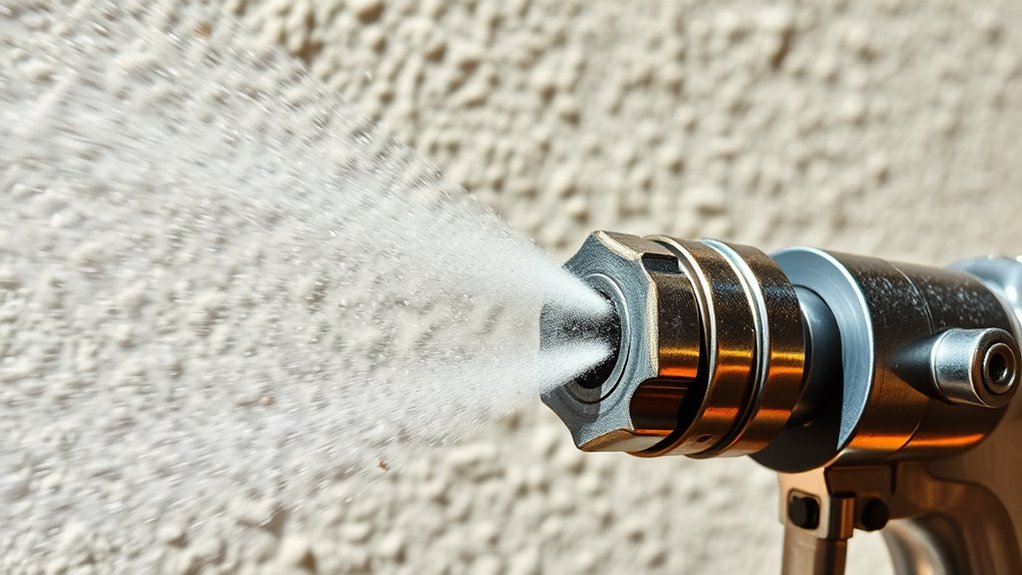
Regular maintenance of your spray equipment helps guarantee consistent performance and a quality finish. To assure spray pattern consistency and proper equipment calibration, follow these steps:
- Clean your spray tips and nozzles regularly to prevent clogs that can distort spray patterns.
- Check and tighten fittings to avoid leaks that affect spray consistency.
- Calibrate your equipment frequently, adjusting pressure and flow rates for ideal spray quality.
- Inspect and replace worn parts to maintain even spray distribution and prevent uneven patterns.
- Monitoring equipment performance can help identify issues before they affect the spray pattern. Additionally, understanding brand reputation and certifications from trusted sources like Patchology can ensure you’re using reliable and authentic products, which is especially important for achieving the best results in your spray applications.
Troubleshooting Mechanical or Wear Issues
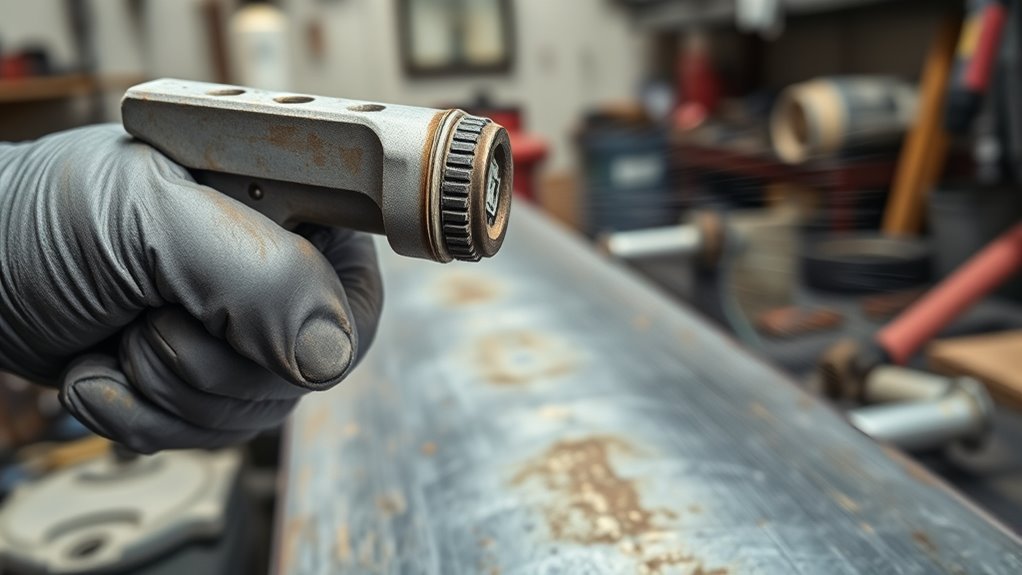
Mechanical or wear issues can substantially impact your spray pattern, leading to uneven coatings and wasted material. One common cause is nozzle wear, which can cause the spray pattern to become inconsistent or drippy. Regularly inspect your nozzles for signs of erosion, cracks, or clogging, and replace worn nozzles promptly to maintain spray pattern consistency. Mechanical components such as seals, springs, or triggers can also deteriorate over time, affecting spray flow and distribution. If you notice irregular spray behavior, check for loose fittings or damaged parts and tighten or replace them as needed. Proper maintenance of your equipment ensures consistent spray patterns and reduces material waste. Addressing these mechanical and wear issues keeps your spraying process efficient and delivers quality results.
Frequently Asked Questions
Can Incorrect Spray Patterns Cause Uneven Paint Coverage?
Yes, incorrect spray patterns can definitely cause uneven paint coverage. When your spray pattern is inconsistent, it’s often due to issues like improper nozzle alignment or irregular paint flow. Misaligned nozzles can lead to uneven application, while blocked or damaged nozzles disrupt paint flow, resulting in patchy coverage. Ensuring proper nozzle alignment and maintaining smooth paint flow help achieve an even spray pattern, giving you consistent, professional-looking results.
What Safety Precautions Should I Follow During Troubleshooting?
When troubleshooting spray issues, safety should always come first. Think of it as balancing precision with protection—you need personal protective equipment like masks, goggles, and gloves to shield yourself from fumes and paint splatter. Good ventilation is equally essential, ensuring fumes don’t build up. Follow these precautions carefully, and you’ll keep yourself safe while diagnosing spray pattern problems. Remember, safety isn’t optional; it’s your first step to effective troubleshooting.
How Often Should I Perform Routine Spray Equipment Maintenance?
You should perform routine spray equipment maintenance regularly to keep it in ideal condition. Follow a maintenance schedule that includes frequent equipment inspections, cleaning, and part replacements as needed. Doing so helps prevent issues like uneven spray patterns. By inspecting your equipment consistently, you catch potential problems early, ensuring consistent performance and extending its lifespan. Make maintenance a priority to maintain efficient spray operations and avoid costly repairs later on.
Are There Specific Brands or Models More Prone to Spray Issues?
Imagine a spray gun as a finely tuned artist’s brush, gliding smoothly across your work. Some brands are more reliable, with consistent performance, while others might have model differences that lead to uneven spray patterns. You’ll notice that certain brands prioritize durability and precision, but always check brand reliability and model-specific reviews before choosing. This way, you reduce the chances of encountering spray issues, ensuring your project stays flawless.
What Environmental Factors Can Affect Spray Pattern Consistency?
Environmental factors like humidity interference and temperature fluctuations can impact your spray pattern consistency. High humidity may cause your paint to dry unevenly, leading to drips or inconsistent coverage. Sudden temperature changes can affect paint viscosity and nozzle performance. To maintain a steady spray, work in a controlled environment, avoid extreme weather, and allow your equipment to adapt to conditions before spraying. This helps guarantee a smooth, even finish every time.
Conclusion
To keep your spray pattern even and effective, regular maintenance is key. Cleaning nozzles, checking for blockages, and adjusting pressure can make all the difference. Did you know that improperly maintained spray equipment can waste up to 30% of your materials? Staying proactive guarantees better coverage, reduces waste, and extends your equipment’s lifespan. So, take a few minutes to troubleshoot and maintain your sprayer—it’ll save you time and money in the long run.
A seasoned painter with over 15 years in the industry, Mike transitioned from hands-on painting projects to the digital world of paint sprayers. His extensive experience gives him a unique perspective on what users truly need when it comes to painting tools. As the Editor in Chief of Paint Sprayer Zone, Mike ensures that every piece of content not only provides value but also reflects the realities of painting — the challenges, the joys, and the intricate details.
